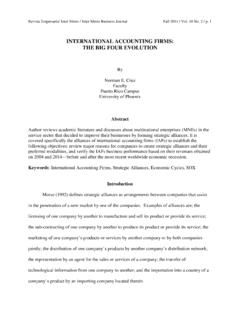Transcription of The Big Four: Contrast, Repetition, Alignment, Proximity
1 152 Presentation Zen153 Chapter 6 Presentation Design: Principles and TechniquesOn this page you can see five samples of simple slides in which elements were arranged with the help of the rule of thirds grid (you can easily create your own using the guides in Keynote or PowerPoint). The rule of thirds is not a rule at all, it is only a guideline. But it is a very useful guideline to use when you are aiming to achieve a balanced look. You ll also notice that the images themselves have pretty good rule of third proportions.
2 The iStockphoto images were chosen in part based on the photo s proportions and how the image guided the eye and contained empty space for text or other design elements. (Images used for the slides on this page are from )The big four : Contrast, Repetition, Alignment, ProximityThese four principles are not all there is to know about graphic design, but understanding these simple related concepts and applying them to slide design can make for far more satisfying and effective simply means difference. And for whatever reason perhaps our brains think they are still back in the savannah scanning for wild predators we are all wired to notice differences.
3 We are not conscious of it, but we are scanning and looking for similarities and differences all the time. Contrast is what we notice, and it s what gives a design its energy. So you should make elements that are not the same clearly different, not just slightly different. Contrast is one of the most powerful design concepts of them all because really any design element can be contrasted with another. You can achieve contrast in many ways for example, through the manipulation of space (near and far, empty and filled), through color choices (dark and light, cool and warm), by text selection (serif and sans serif, bold and narrow), by positioning of elements (top and bottom, isolated and grouped), and so on.
4 Making use of contrast can help you create a design in which one item is clearly dominant. This helps the viewer get the point of your design quickly. Every good design has a strong and clear focal point and having a clear contrast among elements (with one being clearly dominant) helps. If all items in a design are of equal or similar weight with weak contrast and with nothing being clearly dominant, it is difficult for the viewer to know where to begin. Designs with strong contrast attract interest, and help the viewer make sense of the visual.
5 Weak contrast is not only boring, but it can be confusing. Every single element of a design such as line, shape, color, texture, size, space, type, and so on can be manipulated to create contrast. On the next page are some slides that make good use of contrast compared with slides that have weaker 2008 by Garr ReynoldsCopyright 2008 by Garr ReynoldsSample pages from Chapter six of Presentation Zen: Simple Ideas on Presentation Design and Delivery by Garr Reynolds154 Presentation Zen155 Chapter 6 Presentation Design: Principles and TechniquesRepetitionThe principle of repetition simply means the reusing of the same or similar elements throughout your design.
6 Repetition of certain design elements in a slide or among a deck of slides will bring a clear sense of unity, consistency, and cohesiveness. Where contrast is about showing differences, repetition is about subtly using elements to make sure the design is viewed as being part of a larger whole. If you use a stock template from your software application, then repetition is already built into your slides. For example, a consistent background and consistent use of type adds unity across a deck of slides. However, you must be careful not to have too much repetition among your slides.
7 Most of the built-in templates have been seen many times before and may not suit your unique situation. Many of the standard templates also have background elements that will soon become tiring, rather than generating interest the tenth time a different slide is shown but with the same repetitive element. For example, a starfish in the lower right (not my favorite but perhaps appropriate for a presentation on marine biology) is an element that would be a stronger repetitive element if its size and location occasionally shifted in harmony with the content of different slides and in a way that was subtle and did not interfere with the primary slides on the next page are a good example of repetition.
8 In these slides from a presentation on the process of designing a book, Swiss designer and photographer Markuz Wernli Saito used his own full bleed photos for all his slides. To help give the entire presentation a unified look, he used a similar red note and paperclip to hold his text in each slide. The placement of the note and paperclip image was not always in the same location in every slide, nor was the size always the same, but the consistent use of this one element and the red color served to ad a subtle repetitive element that gave his visuals a professional and unified CONTRASTBETTER CONTRASTC opyright 2008 by Garr ReynoldsCopyright 2008 by Garr Reynolds156 Presentation Zen157 Chapter 6 Presentation Design.
9 Principles and TechniquesAlignmentThe whole point of the alignment principle is that nothing in your slide design should look as if it were placed there randomly. Every element is connected visually via an invisible line. Where repetition is more concerned with elements across a deck of slides, alignment is about obtaining unity among elements of a single slide. Even elements that are quite far apart on a slide should have a visual connection, something that is easier to achieve with the use of grids. When you place elements on a slide, try to align them with another element.
10 Many people fail to make an effort to apply the alignment principle, which often results in elements being almost aligned but not quite. This may not seem like a big deal, but these kinds of slides look less sophisticated and overall less professional. The audience may not be conscious of it, but slides that contain elements in alignment look cleaner. And assuming other principles are applied harmoniously as well, your slides should be easier to understand principle of Proximity is about moving things closer or farther apart to achieve a more organized look.










